Bain 1st Round Case – BlissOttica
Our client is a BlissOttica, an Eyewear Manufacturer that is looking to reach a 10% increase in profits. How would you help our client?
Case Comments
This case is a variation of a Bain 1st round case.
The case aims to test the ability of the candidate to:
- Interpret graphs and compare them to derive insights
- Perform correctly math related to graphs
- State hypotheses and define a structured approach based on them
- - - - - - - - - - - - - - - - - - - - - - - - - - - - - - - - - - - - - - - - - - - - - - - - - - - - - - - - - -
To keep a structured approach in assessing the performance of the candidate, it is recommended that the interviewer uses a scoring system to evaluate the 5 parts of the case presented below. This will help the candidate to understand his/her level of readiness for the actual interview.
A possible grading system for each part is the following:
- 0 – Bad answer. The answer is wrong, largely incomplete or anyway incomprehensible for the interviewer due to lack of good communication
- 1 – Average answer. The answer includes part of the correct solution, however it is missing a few relevant points. Alternatively, it is complete but not communicated well
- 2 – Great answer. The answer is complete and well communicated
A possible evaluation grid is the following:
- 8-10 points: clear pass
- 6-8 points: potentially pass
- 6 points and below: did not pass
You can adapt the grading system and the evaluation grid according to your needs.
The text presents the questions to ask, the proposed optimal answer and the suggestions to score a candidate performance in each area.
Part 1 - Case Opening
Note for Interviewer
After presenting the prompt, wait for the candidate to ask clarifying questions and/or present the structure.
Information to be shared only under request:
- BlissOttica offers high-end eyewear for both sunglasses and prescription glasses. It is one of the largest manufacturers worldwide
- The target market for expansion is the US
- The timeline for the goal is 1 year
- The profitability for the client is 5%. An increase in revenues for the client would lead to keep the same 5% profitability
- Costs cannot be decreased further
- Revenues come 80% from retail and 20% from online sales (this piece of information is not useful in this particular case)
- Current revenues of the client are $1.2B
- The client can invest $50M in the new growth strategy
The information about revenues at $1.2B and profitability stable at 5% should lead the candidate to deduce we will have to reach an additional $120M in revenues to reach the goal.
If the candidate proposes to analyze costs, explain the 5% profit margin cannot be increased and redirect him/her to focus on revenues only.
Example of an excellent answer (score: 2)
GOAL CLARIFICATION
An excellent candidate would clarify the objective in terms of current profits, budget and time constraints and understand the source of revenues.
STRUCTURE
A great candidate would include in the analysis the following elements:
- Segmentation of profit sources for the client
- Identification of areas not performing, if present
- Analysis of revenues and costs for that area
- Analysis of possible reasons for bad performance in revenues and costs
- Strategy to increase revenues and/or decrease costs
The candidate may state a hypothesis when presenting the structure.
The candidate may include additional elements, but there should be a rationale related to the objective of BlissOttica.
COMMUNICATION
An excellent candidate should present clearly the different areas in a structured way.
Moreover, the candidate should clearly present the rationale why he/she wants to explore a particular point, connecting the answer to the objective of the client.
Suggested score
An excellent candidate should:
- Clarify the goal of the client
- Include the main elements in the structure as presented above
- Communicate the structure in a clear way
Recommended score calculation: starting from 2, decrease the score by 0,5 points down to 0 for any of the following:
- The candidate did not clarify the objective
- The candidate did not include two or more of the areas described above
- The candidate included multiple useless elements in the structure (ie boiling the ocean)
- The candidate communicated the structure in a disorganized way or without a clear connection to the goal
Part 2 – Analysis of Optimal Segments
Note for Interviewer
Once the candidate asked for information on the current profits, show the following graphs.
Show Exhibit 1 and 2.
"What do you think about these exhibits?"
Note for Interviewer
If the candidate explains that he/she would like to start the analysis from costs, redirect the candidate to think about revenues first, providing the information on the 5% profit margin if not mentioned before.
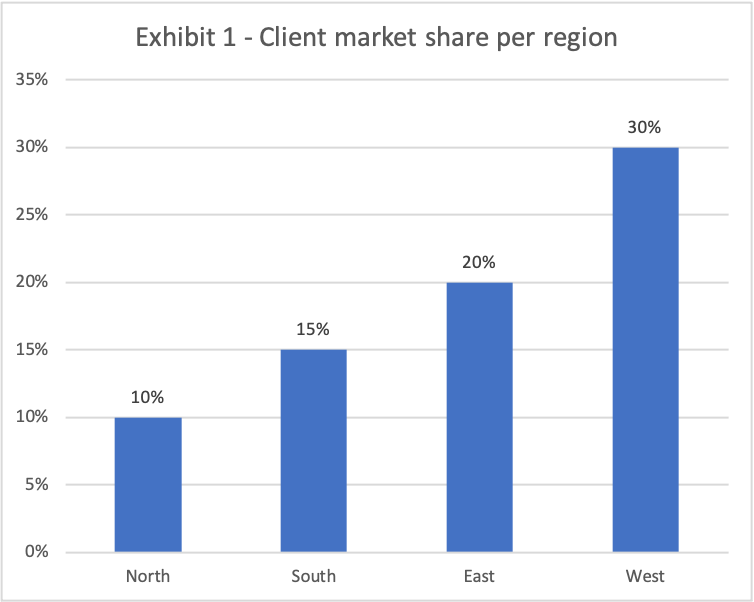
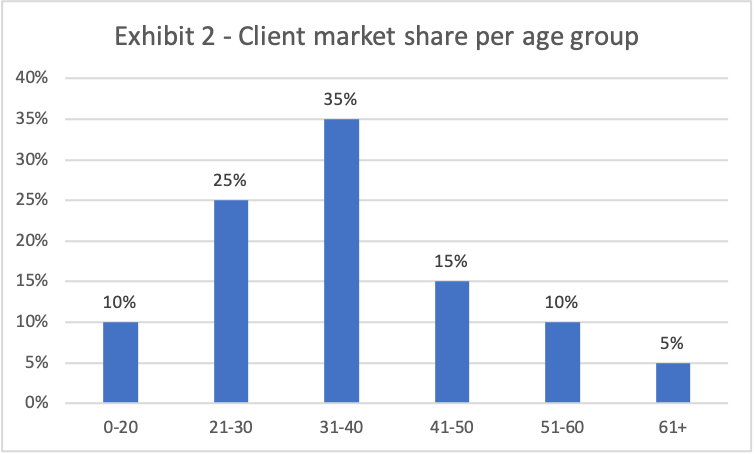
Note for Interviewer
If needed, clarify that the split in age segments is the same for each region.
The graphs show low performance in the North and for age segments 0-20, 41-50 and 51-60. However, there is no comparison with the industry performance. It may well be the North and some age segments are structurally more competitive and there is no option to grow there.
If the candidate suggests to prioritize the North region, ask him/her “Do you think the client performance is the only element to consider here?”
Note for Interviewer
After the candidate asked for Industry information for a comparison, present the following Exhibits.
Show Exhibit 3 and 4.
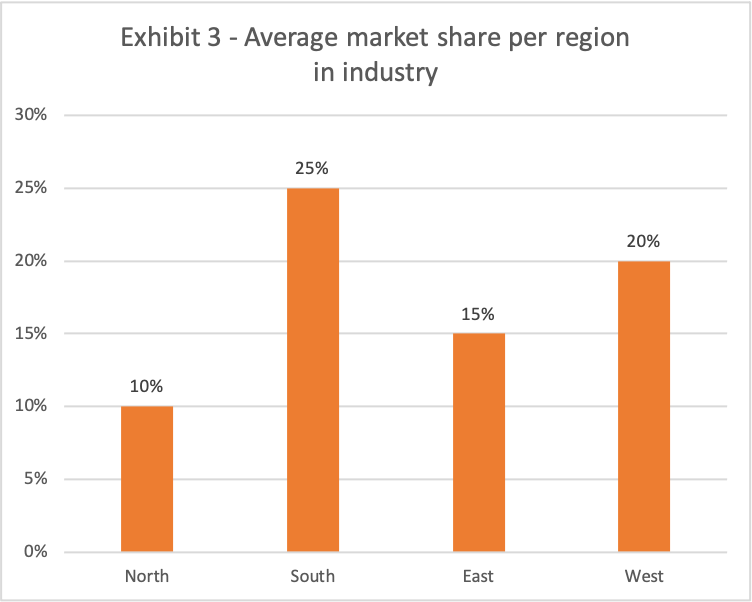
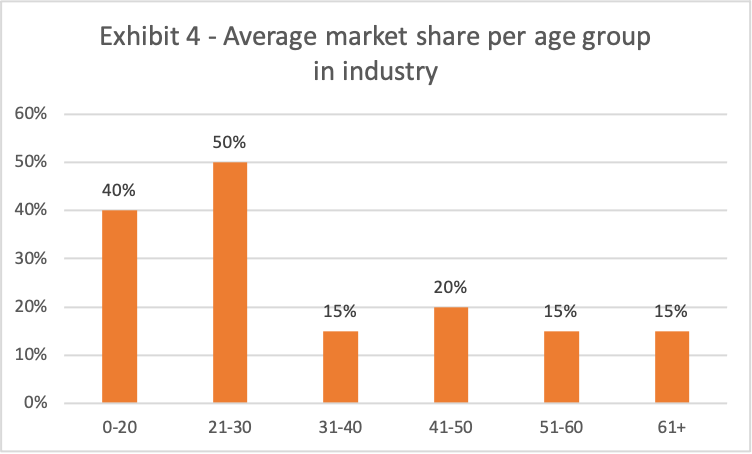
Once received the exhibits, the candidate should present the hypothesis that the most promising segments where to focus are the South and the segment below 30 years. However, that will depend as well on the size of the market and the expected increase in market share in the relevant segments.
The candidate may state hypotheses on different age groups as promising (eg 61+), but should still ask for data to verify that.
The candidate should then ask for information on size and expected market share to verify the hypothesis.
Example of an excellent answer (score: 2)
INFORMATION REQUEST
An excellent candidate would ask for information on the market performance, in order to compare the results of the company with the market.
GRAPH ANALYSIS STRUCTURE
A great candidate will state the hypothesis that the largest opportunity for the client is in the South area and below the 30-year segment. This however should be checked by analyzing the size of the market and the market share achievable in those segments.
NEXT STEPS
An excellent candidate would move to analyze the size of each segment and the market share that may be expected there.
Suggested score
An excellent candidate should:
- Ask for information on the market performance
- Identify the ideal segment as “South” and “Below 30 years”
- Propose next steps related to quantify the additional revenues that could be generated in that area
Recommended score calculation: starting from 2, decrease the score by 0,5 point down to 0 for any of the following:
- The candidate did not ask for additional information on the market performance
- The candidate spent several minutes analyzing the information in the graph without identifying the key trends
- The candidate did not state a hypothesis on the optimal segments
- The candidate did not suggest to move to the next steps analyzing the size and market share obtainable in each segment
Part 3 – Math Question Part 1
Note for Interviewer
The candidate should have proposed autonomously to move to the next steps and calculate the size and market share available for each segment. If not, ask the following:
"Are you sure you should not verify your assumptions on the size and market share we may reach?"
Once asked, mention the following:
"Assume each region has the same market potential. How would you estimate the expected revenues if we reach the average market share in the geographic areas where our performance is currently below average?"
Some candidates will start to perform the math immediately without presenting a structure upfront. An ideal candidate will explain step-by-step the math theory, then move to the numbers.
Note that the candidate doesn’t need to calculate the revenues for each age group to answer the question, but only calculate the additional revenues for the region. If the candidate starts to analyze age groups, redirect him/her accordingly.
The candidate should identify the new revenue potential as $160M, according to the math in the solution below.
Example of an excellent answer (score: 2)
INFORMATION REQUEST
An excellent candidate would ask for information on the size of the segments and the expected market share to be achieved.
LOGIC TO FOLLOW
A great candidate would identify that the optimal process involves calculating the new size for the South market.
MATH STRUCTURE
This is a relatively complex math problem and it is critical that the candidate correctly verbalizes what he/she wants to do.
An excellent candidate would clearly present the theory of the math before performing the actual math.
A possible verbal explanation is the following:
"I understand the client would reach the average market share of 25% in the South, where we are currently below that level.
I also understand each region has the same market potential. So I think that we may first calculate the sum of the market potential in all regions, then divide it by 4 to find the market potential in the South, and then find the additional revenues that could be made with a 25% market share.
Now, to calculate the total market potential - let me see - well we know what the client is doing which is $1.2B, and we can calculate what market share that represents out of the total - that would be the sum of the market share in the 4 different regions divided by 4, because, as mentioned, the 4 markets are of the same size..
So that's how I would propose to proceed:
- We can calculate what is the cumulated market share of the client
- We find the proportion of that out of the total market. We can assume the total market would be 4, given that each market has the same weight, so each market would be equal to 1
- We can derive from that the total size of the market by dividing the client’s total revenues by their overall market share
- We calculate the market size potential in the South by dividing the total market potential by 4
- We calculate the additional revenues assuming a 25% market share instead of 15%"
The different components to calculate the result are the following:
1. We can calculate what is the cumulated market share of the client
⮕ Sum of market share of BlissOttica: Sum of the current market share in the different markets
2. We find the proportion of that out of the total market
⮕ Overall market share of BlissOttica: Sum of market share of BlissOttica /Total possible market share
3. We can derive from that the total size of the market
⮕ Total market potential: Current revenues of BlissOttica/ Overall market share of BlissOttica
4. We calculate the market size potential in the South
⮕ South market: Total market potential / Number of markets
5. We calculate the additional revenues assuming a 25% market share instead of 15%
⮕ New revenues: South Market*(New market share-Old market share)
MATH COMPUTATION
A great candidate would perform the math correctly, aligning with the interviewer and avoiding computations for options not feasible. Following the previous formula, the math computation is the following:
1. We can calculate what is the cumulated market share of the client
⮕ Sum of market share of BlissOttica: Sum of the current market share in the different markets = 0.75
2. We find the proportion of that out of the total market
⮕ Overall market share of BlissOttica: Sum of market share of BlissOttica /Total possible market share = 0,75/4 = 0,1875
3. We can derive from that the total size of the market
⮕ Total market potential: Current revenues of BlissOttica/ Overall market share of BlissOttica = $1.2B/ 0.1875 = $6.4B
4. We calculate the market size potential in the South
⮕ South market: Total market potential / Number of markets = $6.4B / 4 = $1.6B
5. We calculate the additional revenues assuming a 25% market share instead of 15%
⮕ New revenues: South Market*(New market share-Old market share) = $1.6B*(25%-15%)=$160M
NEXT STEPS
An excellent candidate would conclude that reaching the target is possible with an expansion in the South, since keeping the same profitability at 5%, a 10% increase in profits means a 10% increase in revenues, that is $120M, which can be achieved in that region. The candidate should then propose an analysis to organize the expansion in the South, in order to reach the desired level of revenues.
Suggested score
An excellent candidate should:
- Ask for information on the expected market share and size of each market
- Present the structure upfront before performing the math
- Correctly calculate the size of the additional market available in the South
- Identify that the market in the South is sufficient to reach the target and propose to look at the best way to expand there
Recommended score calculation: starting from 2, decrease the score by 0,5 point down to 0 for any of the following:
- The candidate made assumptions on the expected market share and size of the market without verifying them
- The candidate did not present a structure before performing the math
- The candidate did mistakes performing the math
- The candidate did not identify that the additional revenues would allow to reach the goal
Part 4 – Math Question Part 2
Note for Interviewer
Following the solution in the previous part, ask the following to the candidate.
"Let’s now say that we could focus only on 2 age groups for the expansion in the South. Which would be the ideal one to target?"
A great candidate would ask for the market dimension of each age group, and the expected market share that we may reach there. If the candidate doesn’t do so, mention the following:
"What do you think is the key information needed to calculate the additional revenues?"
Note for Interviewer
Once asked, show Exhibit 5, explaining that the client may reach the average market share per segment when the current one is lower.
Show Exhibit 5.
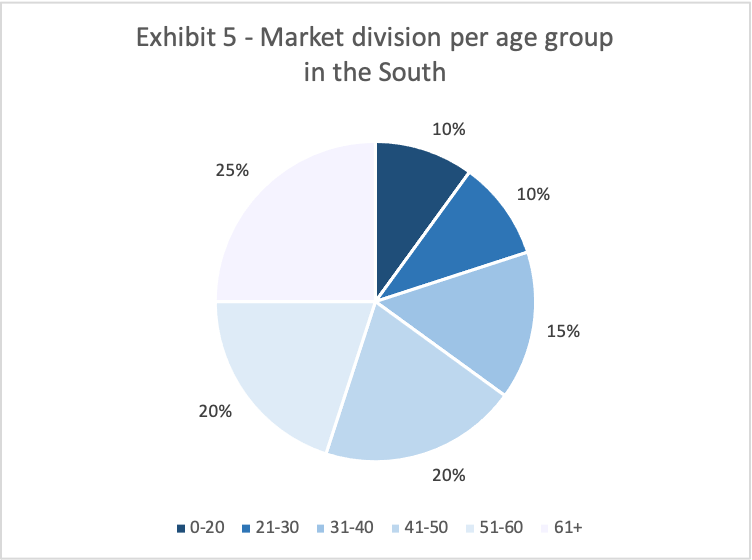
The candidate should calculate the segments with the highest potential in two steps:
- Calculate the market size of each segment
- Calculate the revenues that can be achieved there
The candidate should identify that the best segments to enter are 0-20, followed by 21-30 and 61+. Having to choose 2 segments the 0-20 and 21-30 seem the most logical, given that they probably share synergies. However, the candidate should recognize that it is necessary to enter three segments, as two won’t allow to reach the minimum target of $120M.
Example of an excellent answer (score: 2)
INFORMATION REQUEST
An excellent candidate would ask for information on the size of each age group and the expected market share to be achieved.
LOGIC TO FOLLOW
A great candidate would identify that the optimal process involves (i) identify the market size for each segment (ii) estimate the old and new revenues that could be generated (iii) choose the 2 segments with the highest additional revenues.
MATH STRUCTURE
An excellent candidate would clearly present the math formula before performing the actual math. The correct formulas to use are the following:
- Market size for each segment: South market size*Age group market share
- Old revenues per segment: Market size segment* Old market share from Exhibit 2
- New revenues per segment: Market size segment * New market share from Exhibit 4
- Additional revenues: New revenues – Old revenues
MATH COMPUTATION
A great candidate would perform the math correctly, aligning with the interviewer and avoiding computations for options not feasible.
Following the previous formula, the math computation is the following:
Market size for each segment:
- 0-20: $1.6B*10% = $160M
- 21-30: $1.6B*10% = $160M
- 31-40: $1.6B*15% = $240M
- 41-50: $1.6B*20% = $320M
- 51-60: $1.6B*20% = $320M
- 61+: $1.6B*25% = $400M
Old revenues per segment:
- 0-20: $160M*10% = $16M
- 21-30: $160M*25% = $40M
- 31-40: $240M*35% = $84M
- 41-50: $320M*15% = $48M
- 51-60: $320M*10% = $32M
- 61+: $400M*5% = $20M
New revenues per segment:
- 0-20: $160M*40% = $64M
- 21-30: $160M*50% = $80M
- 31-40: $240M*35% = $84M (current market share is higher)
- 41-50: $320M*20% = $64M
- 51-60: $320M*15% = $48M
- 61+: $400M*15% = $60M
Additional revenues:
- 0-20: $64M-$16M = $48M
- 21-30: $80M-$40M = $40M
- 31-40: $84M-$84M = 0$M
- 41-50: $64M-$48M = $16M
- 51-60: $48M-$32M = $16M
- 61+: $60M-$20M = $40M
Ideally, the candidate will build a table like the following to keep information organized (this is not strictly necessary though):
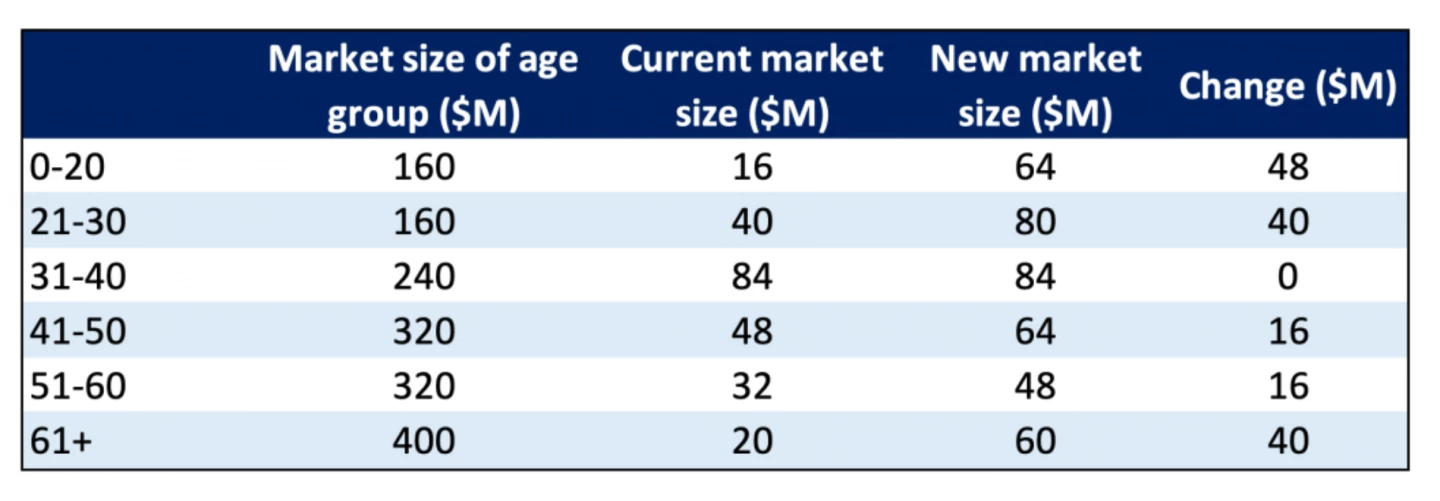
Suggested score
An excellent candidate should:
- Ask for information on the expected market share and size of each segment
- Present the structure upfront before performing the math
- Correctly calculate the additional size of each segment
- Identify that the ideal segments are 0-20, 21-30 and 61+, and notice that the client will need 3 segments to reach its goal
Recommended score calculation: starting from 2, decrease the score by 0,5 point down to 0 for any of the following:
- The candidate made assumptions on the expected market share and size of the market without verifying them
- The candidate did not present a structure before performing the math
- The candidate did mistakes performing the math
- The candidate did not identify the correct segments or that the client will need to expand in three segments to reach the goal
NEXT STEPS
An excellent candidate would conclude that the ideal segments are 0-20 and 21-30 or 61+. Between 21-30 and 61+, the candidate should formulate the hypothesis 21-30 may be easier to penetrate given the fact the segment is closer to 0-20.
However, the candidate should also notice that reaching the target is not possible with just two segments. The client will need to target three segments to be able to successfully reach at least $120M. The candidate should thus suggest to analyze the possible ways to reach this target.
Part 5 – Conclusion
"You have one minute to present your findings to the CEO. What are you going to say?"
Example of an excellent answer (score: 2)
The candidate should:
- Recap the objective
- Provide an answer-first approach to the question asked
- Mention risks and the next steps to take
RECAP OF THE OBJECTIVE
"Our client asked us to understand the best strategy to reach an increase in profits of 10% - or $6M"
CONCLUSION
"In order to reach this target we would recommend to growth in the South segment in the 0-20, 21-30 and 61+ segments, for the following reasons:
- The profitability is expected to remain at 5%
- We will be able to reach a total of $128M in revenues, additional to the current ones – the most of any other segments in the market, thus generating $6.4M in profits
- Covering less than 3 segments would not allow to reach the minimum target of $120M in revenues or $6M in profits”
NEXT STEPS AND RISKS
"As for next steps, we would like to analyze the following:
- Are the capabilities that we have ($50M) enough to implement the plan
- Can we reach the desired results already in the 1st year
- We need to define a structure for an implementation plan to help the client to execute the expansion
We would be happy to support you with all these 3 areas and present a plan to achieve the target in the next few days”
Suggested score
An excellent candidate should:
- Recap the objective of the case
- Present the results of $128M revenues / $6.4M in profits and the need to enter 3 segments
- Propose next steps related to the original structure and to implement the suggested approach
Recommended score calculation: starting from 2, decrease the score by 0,5 point down to 0 for any of the following:
- The candidate did not have an answer-first approach and presented the conclusion in a disorganized way
- The candidate did not provide reasons why the selected segments are ideal for an expansion
- The candidate did not have next steps and/or risks as part of the recommendation
- The candidate spent more than 1,5 minutes to deliver the recommendation
Final Remarks
Thanks for completing the case!
------------------------------------------------------------------------------------------------------------------------
Looking for free tips? Click on the links below to find more information about some of the most common topics in consulting:
- 11 New Consulting Trends You Should Know
- 4 Ways to Land an MBB Interview
- Making $ in the Middle East - 16+ Data Points on Consulting Salaries in Dubai and Co
- How to Make $1M+ by Working in Consulting
- Top 15 Consulting Firms by Revenues and Prestige
- How to Master the 6 Games of the McKinsey Problem Solving Game
- 10 Must-Know Tips to Master the BCG Online Case
- Consulting Firms in Singapore - Learn Everything About 18 Top Consulting Firms in the Lion City
- Revealed: The Real 32 MBB Target Schools for US Applicants
- Salaries of the Best 16 Consulting Firms in Singapore - Everything You Need to Know
- BCG Potential Test - 9 Exclusive Tips
------------------------------------------------------------------------------------------------------------------------
For any questions, please drop me a message here, happy to help.
Best,
Francesco
Market Entry
Master market entry cases in consulting. Learn key strategies, financial analysis, and approaches to successfully enter new markets.
7S-Framework of McKinsey
Discover what McKinsey's 7S framework is and how it helps companies maximize their strengths and identify weaknesses while focusing on 7 internal elements.
Qualitative and Quantitative Analysis
Qualitative and quantitative analysis are two methods in data analysis that are often used in different scenarios and are important for consultants.
Learning Organization
Learning organizations thrive on change through innovation, adaptability & knowledge sharing. Discover how businesses stay ahead in this article!
How to Practice Math Skills
Learn how to practice your math skills to rock your consulting interview.

